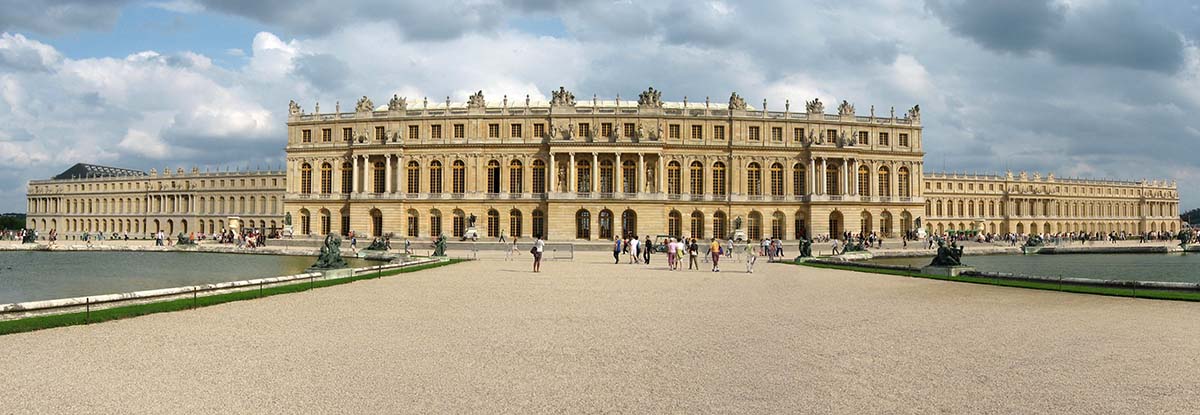
by K.M. Lowe
If you’ve been to Versailles you’ll know that it redefines large. Looking out from the main palace, the gardens go past the horizon in two directions—literally as far as the eye can see. The historic site covers 2,000 acres, making it larger than Manhattan. Once the home of French kings, Versailles can take all day to tour, and you still would not see everything.
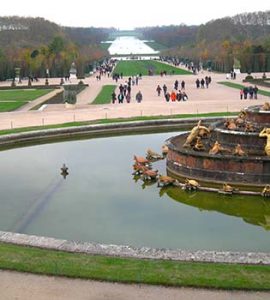 Because of its distance from the main palace, many visitors do not get to a small chāteau on the grounds known as Le Petit Trianon.
Because of its distance from the main palace, many visitors do not get to a small chāteau on the grounds known as Le Petit Trianon.
Originally designed for Louis XV’s mistress, Madame de Pompadour, construction on Le Petit Trianon was begun in 1765. Madame de Pompadour, however, died before the miniature palace was completed, which eventually happened in 1778. The next Louis (XVI) gave the chāteau to his wife, Marie Antoinette, who used it as an escape from the hectic life at court.
Back in the 1980s, I saw a movie on television called, “Miss Morison’s Ghosts.” The programme told the story of two British women who visited the Palace of Versailles on a hot August day in 1901.
While wandering the grounds near the Petit Trianon, the pair of women became disoriented. They subsequently witnessed a series of people and sights that seemed strange, and they also experienced feelings of oppression and dreariness. The event upset them so much that after they had recovered, they did not speak of it for a long time. But when they finally discussed it months later, they learned that they each had seen different sights during the same time period in the same places.
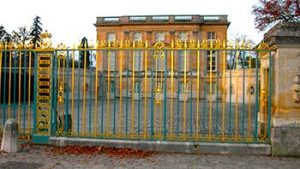 Curious and somewhat disturbed, the women wrote down their individual accounts independently of one another and then compared notes. Surprised by what was revealed in their writings, they began carrying out research on the palace, its history and particularly the small chateau near where they’d witnessed the sights: Le Petit Trianon.
Curious and somewhat disturbed, the women wrote down their individual accounts independently of one another and then compared notes. Surprised by what was revealed in their writings, they began carrying out research on the palace, its history and particularly the small chateau near where they’d witnessed the sights: Le Petit Trianon.
Eventually they learned that their visit to Versailles August 10, 1901 had happened on the anniversary of Louis’s and Marie’s imprisonment during the French Revolution. They discovered descriptions of the property made at the time of the French Revolution that matched what they had seen.
Returning to Versailles (several times in fact), they found the landscape different from their first visit, and records indicated that some of what they had seen did not exist in 1901. It had, however, existed in the 1700s.
Watching the movie “Miss Morison’s Ghosts,” I thought the tale fictional and was surprised to find later that these women did exist. The story had caused a scandal when they published it in 1911 – 10 years after the incident – in a book called, “An Adventure.” They wrote the small booklet using the pseudonyms Elizabeth Morison and Frances Lamont to conceal their identities. This turned out to be a good idea because the book was ridiculed by many, and the authors would likely have faced scorn and ultimately ruin.
After their deaths, however, the authors’ identities were revealed as respected academics Charlotte Anne Moberly and Eleanor Jourdain. In 1901, Moberly was the first Principal of St. Hugh’s College in Oxford, a hall of residence for young women. Jourdain had authored several textbooks and was being considered for the position of assistant to Moberly. Moberly visited Jourdain in Paris, where Jourdain tutored students. They decided to visit some of the sites, and on August 10, they took the train to Versailles.
The book that Jourdain and Moberly wrote had descriptions of everything they saw and heard that day and includes details of music, people, clothing, tools, landscape and buildings. Moberly wrote about “very dignified officials, dressed in long greyish green coats with small three-cornered hats…” She also described a man wearing a cloak and large shady hat whose appearance was “most repulsive… its expression odious. His complexion was dark and rough.” A lady in a summer dress and white hat sketching on the grass was determined by Moberly to have been Marie Antoinette.
Eventually the book they published became known as “The Ghosts of the Trianon,” and the alleged event as the ‘Moberly-Jourdain Incident’ once their true identities were revealed. Over the years, the story has been the topic of scrutiny, ridicule and serious study.
Disbelievers have insisted that these academics were suffering from heatstroke on that sweltering August day. Believers have maintained that they had travelled back in time to the 1700s. Another explanation is that they had inadvertently strayed into a fancy dress party sometimes held on the Versailles grounds by the French avant-garde. The two women themselves thought they may have tapped into psychic memories of Marie Antoinette.
When I eventually found my way to the Palace of Versailles, I was reminded of the story of “The Ghosts of the Trianon.” In addition to wanting to see the grandiosity of this historic location, my love of mysteries drew me to Versailles. Of course we toured the main palace, but I simply had to visit the small chāteau to satisfy my curiosity about the Moberly-Jourdain Incident.
Wide paths walled with massive manicured trees connect the Petit Trianon with the main gardens. In the days of Marie and Louis, travel to and from would have been by carriage. Today, there is a trolley to shuttle visitors back and forth. But I was compelled to walk the same paths that the British academics would have walked in 1901.
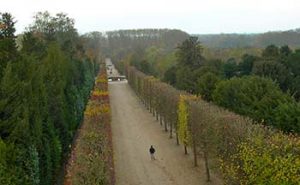 Of course we got lost along the way. You could even say we became disoriented, possibly just as Moberly and Jourdain had more than a century earlier. It is easy to do. The tall trees make it impossible to see anything other than the path you are on, which all look the same and intersect at angles. We found ourselves at dead ends twice and had to backtrack to get around a canal and a fence. And we were there in the autumn without the stifling heat of summer that may have caused even more physical distress.
Of course we got lost along the way. You could even say we became disoriented, possibly just as Moberly and Jourdain had more than a century earlier. It is easy to do. The tall trees make it impossible to see anything other than the path you are on, which all look the same and intersect at angles. We found ourselves at dead ends twice and had to backtrack to get around a canal and a fence. And we were there in the autumn without the stifling heat of summer that may have caused even more physical distress.
We did eventually arrive at the picturesque chāteau with its private gardens and domed gazebo. The building itself has been called “simple and elegant, architecturally correct…” While knowing little of architecture, I must agree. The impression the chāteau gives is: right; appropriate; proper. But I wonder if that is a relative comparison. Could it be that after touring the grand palace, one can’t help but see the small chāteau as more appropriate by contrast? The Trianon gardens certainly contrast with the formal symmetry of the main Versailles gardens. Meandering paths and streams form a nature retreat around a neo-Classical gazebo. Known as the Temple of Love, the gazebo is only a short walk from the chāteau yet because of the vegetation looks and feels isolated and secluded.
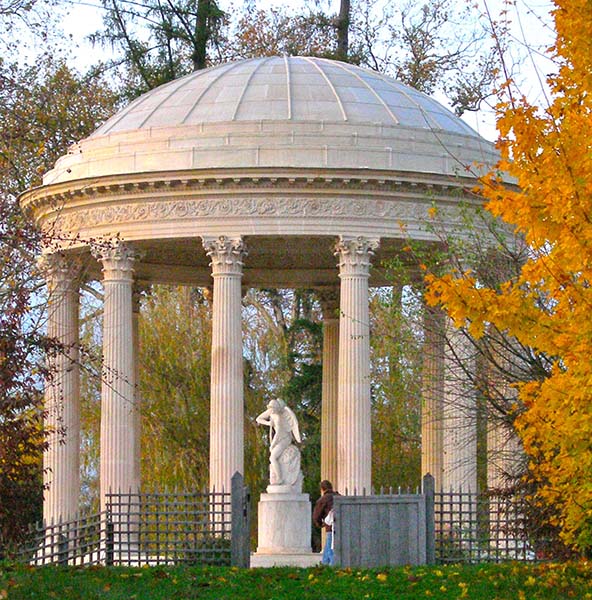 In “Ghosts of the Trainon” or “An Adventure,” Jourdain apparently wrote: “Everything suddenly looked unnatural, therefore unpleasant; even the trees seemed to become flat and lifeless, like wood worked in tapestry. There were no effects of light and shade, and no wind stirred the trees.”
In “Ghosts of the Trainon” or “An Adventure,” Jourdain apparently wrote: “Everything suddenly looked unnatural, therefore unpleasant; even the trees seemed to become flat and lifeless, like wood worked in tapestry. There were no effects of light and shade, and no wind stirred the trees.”
I say she ‘apparently wrote,’ because I have been unable to acquire a copy of the book. However, I must admit that the whole area had a flat, lifeless look to it when I was there, as if it were a life-sized painting. Jourdain is reported to have used the term ‘tableau vivant,’ or living picture, which seems appropriate for what I experienced.
Did I feel the dreariness they’d described? Maybe; there was something unnatural about it all. I wonder though if that had to do with how out of time it appeared—preserved as it would have been for the kings and queens who are now long dead along with the lifestyle they represented. Ghosts of the past, certainly.
As noted early, I have not found a copy to read, and I have also been unable to view the film a second time. For some reason, it is easier to travel to Versailles than it is to get a copy of the film “Miss Morison’s Ghosts” or the book that inspired it.
Sadly, there were no actual ghost sightings for us. But there have been for others. The area is known for ghostly visions and weird occurrences, and a woman matching Marie Antoinette’s description has been seen sketching near the Petit Trianon on more than one occasion. The ‘incident’ experienced by these British academics, however, is the most famous (to date).
If You Go:
Watch the movie below…
About the author:
K.M. Lowe is writer, journalist and corporate communicator. In her 20+ year career, she’s worked at NGOs, high tech, publishers and the media. Her jobs have included communications director, publishing advisor, staff writer, and managing editor. With a passion for story-based communications, she’s written 100+ articles and hundreds of blog posts. She has traveled extensively and lived in Canada and in West Africa. For more information visit: www.kmlowe.com
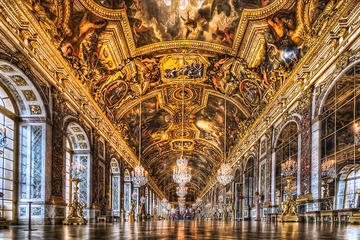
Full Day Private Guided Tour Versailles Castle Gardens Petit Trianon from Paris – $233.65
from: Viator
Photo credits:
Versailles photo #1 courtesy of www.all-free-photos.com.
All other photos by K.M. Lowe:
The palace of Versailles and its grounds combined cover 2,000 acres, making it larger than Manhattan… literally as far as the eye can see
The Petit Trianon chateau was built for the king’s mistress, but she died before it was complete. So when it was finished, he gave it to his wife instead.
Paths from the main palace of Versailles to the Petit Trianon are lined with massive hedges preventing visitors from seeing exactly where they are or where they are going.
There are rumours that Marie Antoinette’s ghost is seen in the small (well, relatively speaking) garden of the Petit Trianon near the Temple of Love.





Leave a Reply
You must be logged in to post a comment.